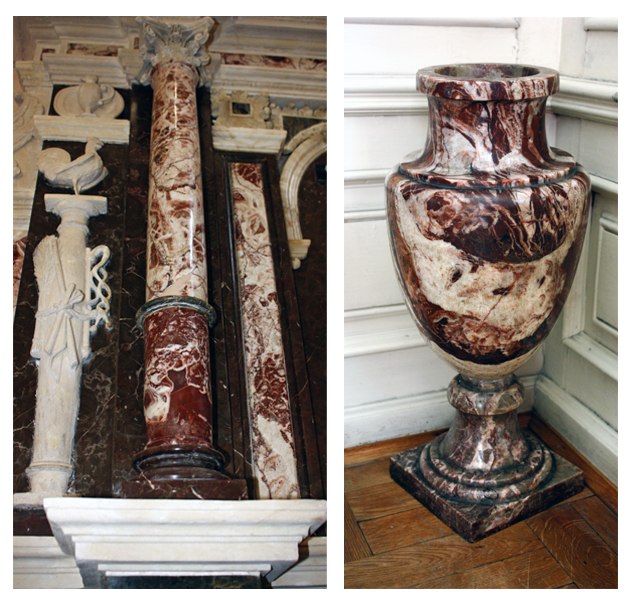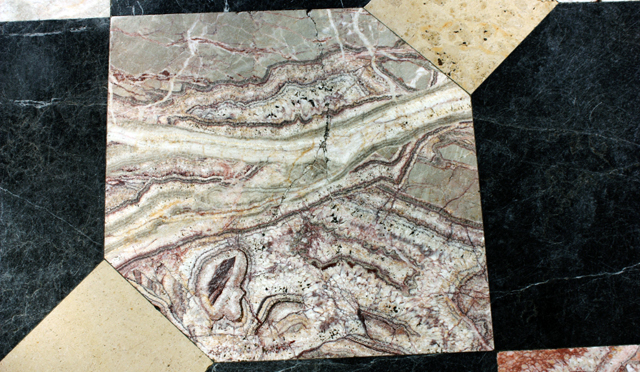The Sleeping Beauty of Żelejowa

The Żelejowa hill, located to the north-east from the village Chęciny, is famous especially for its deposits of an interesting variety of olive coloured Devonian limestone with abundant veins of white or pink colour. Nevertheless, this variety of limestone has not been the most popular material that can be found in this area. That would be a coarse-grained calcite, known as the Sleeping Beauty of Żelejowa.
The name, The Sleeping Beauty of Żelejowa, comes from its unique mineral structure. The lightly coloured calcite grains in the mineral are surrounded by cherry coloured hematite, which is the cause of characteristic rose coloured flowers. Repeated processes of mineralization and the influence of pressure forces have led to the creation of remarkable multi-coloured structures. White and pink calcite coloured by cherry hematite together have created an interesting constellation of colours.
Hydro-thermal solutions are responsible for the creation of the Sleeping Beauty. Hot mineralized water enabled the crystallisation of calcite and other minerals in cracks of the rocks. The first cracks in the Devonian rocks happened during the Variscan tectonic movements in the era of late Carbon. The latest cracks were created during the period of Alpine orogeny. During this time, the abundantly cracked calcite was enriched by elements of lead and copper ores.
The material, mined on the Żelejowa hill, was multicoloured and shaped in stripes, breccias, or arches. The crystalline structure of the Sleeping Beauty of Żelejowa is similar to real marble. The Sleeping Beauty is also unique because it allows for perfect polishing of the surface. This is a characteristic feature which makes it comparable to many Italian marbles.

The veins of the Sleeping Beauty of Żelejowa had the thickness of a few centimetres up to several metres and were several metres or up to several hundred metres long. The presence of material in this form needed special methods of mining which left, until today, visible long and narrow cracks, so called joints. Wooden wedges were used for mining of the Sleeping Beauty. They would be stuck in holes and let to soaking up water. Water would then cause swelling up of the wood and dislodging of the block of mineral from solid rock. Apart from the mining on Żelejowa, you can also notice the cracks left after mining on the hill Stokówka near Gałęzice.
Architectural elements made of the Sleeping Beauty can be found in the decoration of many baroque sacral buildings. Not only in the royal city Krakow, but also in Kielce. Apart from others, there are the details of the main altar in the monastery in Karczówce in Kielce, so called mirror in the portal of the Palace of the bishops of Krakow, also in Wąchock, Jędrzejów and Lisów.
Although, there can be certain complications during the processing of the stone, that are caused by the crystal composition, the Sleeping Beauty calcite can be used to make figural statues. There are the statues from the Gostomsky tombstone that is to be found in the collegial church in Środa Wielkopolska, from the time around 1610. An altar that is made from the Sleeping Beauty can be seen in the chapel of Saint Bartholomew, the Apostle in Checiny. It was made in the workshop of Kasper Fodyga in 1914 and it is an exceptional peace of art. The chapel is called the Fodyga Chapel or the Capel of the Three Wise men. It is one of a few chapels in Poland that is consacrated to a townsman.

There is a very interesting example of the use of this material that is documented in the Przypkowskich Family State Museum in Jędrzejow. There is a vase of exceptional quality exhibited in one of the halls that is made of the pink calcite. The facings of columns that can be found today in the museum in the świętokryzska branch of the State Geological Institute in Kielce were made from the last blocks obtained in the quarry in Żelejow.
The mining was finished in 1954. Today, the locality is a protected natural reservation.
Source: Kurier kamieniarski
